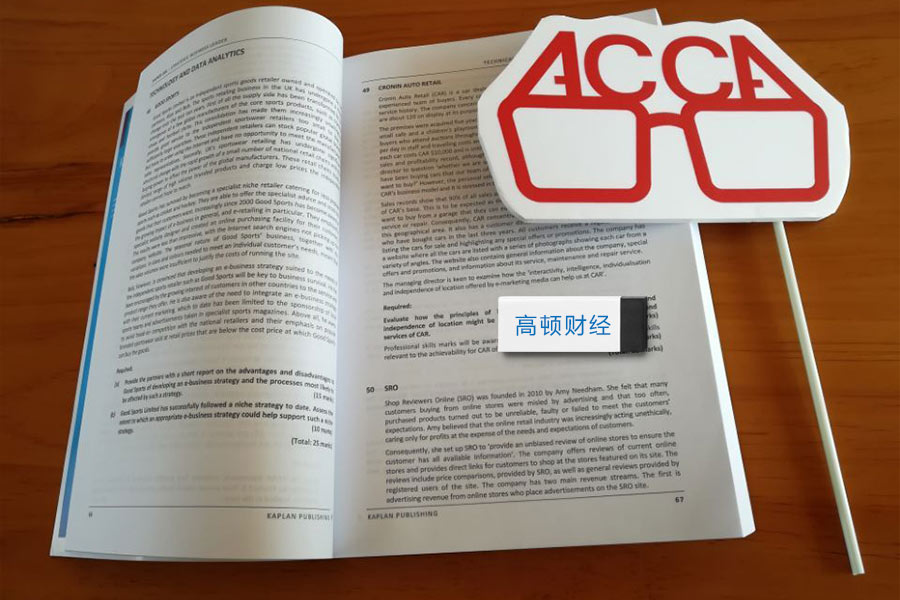2015年ACCA P5 高级业绩管理考试大纲
来源:
高顿网校
2015-03-25
? ACCA 2014 All rights reserved.
1
Advanced Performance
Management (P5)
December 2014 & June
2015
This syllabus and study guide is designed to help
with planning study and to provide detailed
information on what could be assessed in
any examination session.
THE STRUCTURE OF THE SYLLABUS AND
STUDY GUIDE
Relational diagram of paper with other papers
This diagram shows direct and indirect links
between this paper and other papers preceding or
following it. Some papers are directly underpinned
by other papers such as Advanced Performance
Management by Performance Management. These
links are shown as solid line arrows. Other papers
only have indirect relationships with each other
such as links existing between the accounting and
auditing papers. The links between these are shown
as dotted line arrows. This diagram indicates where
you are expected to have underpinning knowledge
and where it would be useful to review previous
learning before undertaking study.
Overall aim of the syllabus
This explains briefly the overall objective of the
paper and indicates in the broadest sense the
capabilities to be developed within the paper.
Main capabilities
This paper’s aim is broken down into several main
capabilities which divide the syllabus and study
guide into discrete sections.
Relational diagram of the main capabilities
This diagram illustrates the flows and links between
the main capabilities (sections) of the syllabus and
should be used as an aid to planning teaching and
learning in a structured way.
Syllabus rationale
This is a narrative explaining how the syllabus is
structured and how the main capabilities are linked.
The rationale also explains in further detail what the
examination intends to assess and why.
Detailed syllabus
This shows the breakdown of the main capabilities
(sections) of the syllabus into subject areas. This is
the blueprint for the detailed study guide.
Approach to examining the syllabus
This section briefly explains the structure of the
examination and how it is assessed.
Study Guide
This is the main document that students, learning
and content providers should use as the basis of
their studies, instruction and materials.
Examinations will be based on the detail of the
study guide which comprehensively identifies what
could be assessed in any examination session.
The study guide is a precise reflection and
breakdown of the syllabus. It is divided into sections
based on the main capabilities identified in the
syllabus. These sections are divided into subject
areas which relate to the sub-capabilities included
in the detailed syllabus. Subject areas are broken
down into sub-headings which describe the detailed
outcomes that could be assessed in examinations.
These outcomes are described using verbs
indicating what exams may require students to
demonstrate, and the broad intellectual level at
which these may need to be demonstrated
(*see intellectual levels below)。
INTELLECTUAL LEVELS
The syllabus is designed to progressively broaden
and deepen the knowledge, skills and professional
values demonstrated by the student on their way
through the qualification.
The specific capabilities within the detailed
syllabuses and study guides are assessed at one of
three intellectual or cognitive levels:
LevelⅠ: Knowledge and comprehension
? ACCA 2014 All rights reserved.
2
LevelⅡ: Application and analysis
LevelⅢ: Synthesis and evaluation
Very broadly, these intellectual levels relate to the
three cognitive levels at which the Knowledge
module, the Skills module and the Professional level
are assessed.
Each subject area in the detailed study guide
included in this document is given a 1, 2, or
3 superscript, denoting intellectual level, marked at
the end of each relevant line. This gives an
indication of the intellectual depth at which an area
could be assessed within the examination. However,
while level 1 broadly equates with the Knowledge
module, level 2 equates to the Skills module and
level 3 to the Professional level, some lower level
skills can continue to be assessed as the student
progresses through each module and level. This
reflects that at each stage of study there will be a
requirement to broaden, as well as deepen
capabilities. It is also possible that occasionally
some higher level capabilities may be assessed at
lower levels.
LEARNING HOURS AND EDUCATION
RECOGNITION
The ACCA qualification does not prescribe or
recommend any particular number of learning hours
for examinations because study and learning
patterns and styles vary greatly between people and
organisations. This also recognises the wide
diversity of personal, professional and educational
circumstances in which ACCA students find
themselves.
As a member of the International Federation of
Accountants, ACCA seeks to enhance the education
recognition of its qualification on both national and
international education frameworks, and with
educational authorities and partners globally. In
doing so, ACCA aims to ensure that its qualifications
are recognized and valued by governments,
regulatory authorities and employers across all
sectors. To this end, ACCA qualifications are
currently recognized on the education frameworks in
several countries. Please refer to your national
education framework regulator for further
information.
Each syllabus contains between 23 and 35 main
subject area headings depending on the nature of
the subject and how these areas have been broken
down.
GUIDE TO EXAM STRUCTURE
The structure of examinations varies within and
between modules and levels.
The Fundamentals level examinations contain
100% compulsory questions to encourage
candidates to study across the breadth of each
syllabus.
The Knowledge module is assessed by equivalent
two-hour paper based and computer based
examinations.
The Skills module examinations F5-F9 are all paper
based three-hour papers containing a mix of
objective and longer type questions. The Corporate
and Business Law (F4) paper is a two- hour
computer based objective test examination which is
also available as a paper based version from the
December 2014 examination session.
The Professional level papers are all three-hour
paper based examinations, all containing two
sections. Section A is compulsory, but there will be
some choice offered in Section B.
For all three hour examination papers, ACCA has
introduced 15 minutes reading and planning time.
This additional time is allowed at the beginning of
each three-hour examination to allow candidates to
read the questions and to begin planning their
answers before they start writing in their answer
books. This time should be used to ensure that all
the information and exam requirements are properly
read and understood.
During reading and planning time candidates may
only annotate their question paper. They may not
write anything in their answer booklets until told to
do so by the invigilator.
The Essentials module papers all have a Section A
containing a major case study question with all
requirements totalling 50 marks relating to this
case. Section B gives students a choice of two from
three 25 mark questions.
? ACCA 2014 All rights reserved.
3
Section A of both the P4 and P5 Options papers
contain one 50 mark compulsory question, and
Section B will offer a choice of two from three
questions each worth 25 marks each.
Section A of each of the P6 and P7 Options papers
contains 60 compulsory marks from two questions;
question 1 attracting 35 marks, and question 2
attracting 25 marks. Section B of both these
Options papers will offer a choice of two from three
questions, with each question attracting 20 marks.
All Professional level exams contain four
professional marks.
The pass mark for all ACCA Qualification
examination papers is 50%.
GUIDE TO EXAMINATION ASSESSMENT
ACCA reserves the right to examine anything
contained within the study guide at any examination
session. This includes knowledge, techniques,
principles, theories, and concepts as specified.
For the financial accounting, audit and assurance,
law and tax papers except where indicated
otherwise, ACCA will publish examinable
documents once a year to indicate exactly
what regulations and legislation could potentially be
assessed within identified examination sessions
For paper based examinations regulation issued or
legislation passed on or before 31st August annually,
will be examinable from 1st September of the
following year to 31st August t of the year after that.
Please refer to the examinable documents for the
paper (where relevant) for further information.
Regulation issued or legislation passed in
accordance with the above dates may be
examinable even if the effective date is in the future.
The term issued or passed relates to when
regulation or legislation has been formally approved.
The term effective relates to when regulation or
legislation must be applied to an entity transactions
and business practices.
The study guide offers more detailed guidance on
the depth and level at which the examinable
documents will be examined. The study guide
should therefore be read in conjunction with the
examinable documents list.
? ACCA 2014 All rights reserved.
4
Syllabus
AIM
To apply relevant knowledge, skills and exercise
professional judgement in selecting and applying
strategic management accounting techniques in
different business contexts and to contribute to the
evaluation of the performance of an organisation
and its strategic development.
MAIN CAPABILITIES
On successful completion of this paper, candidates
should be able to:
On successful completion of this paper, candidates
should be able to:
A Use strategic planning and control models
to plan and monitor organisational performance
B Assess and identify relevant macro economic,
fiscal and market factors and key external
influences on organisational performance
C Identify and evaluate the design features of
effective performance management information
and monitoring systems
D Apply appropriate strategic performance
measurement techniques in evaluating and
improving organisational performance
E Advise clients and senior management on
strategic business performance evaluation and
on recognising vulnerability to corporate failure
F Identify and assess the impact of current
developments in management accounting and
performance management on measuring,
evaluating and improving organisational
performance
RELATIONAL DIAGRAM OF MAIN CAPABILITIES
PM (F5)
APM (P5)
MA (F2)
BA (P3)
Strategic planning and control (A)
Performance
measurement
systems and design (C)
Strategic performance
measurement
(D)
Performance evaluation and corporate failure
(E)
Current developments and emerging issues in management accounting and
performance management
(F)
Economic, fiscal, market and environmental factors (B)
? ACCA 2014 All rights reserved.
5
RATIONALE
The Advanced Performance Management syllabus
further develops key aspects introduced in Paper
F5, Performance Management, at the skills level
and draws on aspects of the material covered from a
more strategic and operational planning perspective
in Paper P3, Business Analysis.
The syllabus introduces candidates to the strategic
role of management accounting as a discipline for
planning and controlling performance so that
strategic objectives can be set, monitored and
controlled. It also covers the impact of external
factors on strategic management issues, such as
macro economic, fiscal, market and environmental
impacts on performance. From appreciating the
strategic context of performance management and
the impact of wider factors, the syllabus examines,
at an operational level, the issues relating to
performance measurement systems and their
design.
The syllabus then moves from performance
management systems and their design to the scope
and application of high-level performance
measurement techniques in a variety of contexts,
including not-for-profit organisations and multinational
businesses. Having covered the strategic
aspects of performance management and
operational systems for the measurement and
control of performance in a variety of contexts,
candidates are then expected to synthesise this
knowledge in the role of an advisor to senior
management or independent clients on how to
assess and control the performance of an entity,
including the recognition of whether a business is
facing difficulties or possibly failure.
Finally, the syllabus deals with current
developments in performance management and
with emerging issues as they might affect or
influence the management of performance within
organisations.
? ACCA 2014 All rights reserved.
6
DETAILED SYLLABUS
A. Strategic planning and control
1. Introduction to strategic management
accounting
2. Performance management and control of the
organisation
3. Changes in business structure and
management accounting
4. Effect of Information Technology (IT) on
strategic management accounting
5. Other environmental and ethical issues
B. External influences on organisational
performance
1. Changing business environment
2. Impact of external factors on strategy and
performance
C. Performance measurement systems and design
1. Performance management information systems
2. Sources of management information
3. Recording and processing methods
4. Management reports
D. Strategic performance measurement
1. Performance hierarchy
2. Strategic performance measures in private
sector
3. Divisional performance and transfer pricing
issues
4. Strategic performance measures in not-forprofit
organisations
5. Non- financial performance indictors
6. The role of quality in management information
and performance measurement systems
7. Performance measurement and strategic
human resource management issues
8. Performance measurement and the reward
systems
9. Other behavioural aspects of performance
measurement
E. Performance evaluation and corporate failure
1. Alternative views of performance measurement
and management
2. Strategic performance issues in complex
business structures
3. Predicting and preventing corporate failure
F. Current developments and emerging issues
performance management
1. Current developments in management
accounting techniques
2. Current issues and trends in performance
management
? ACCA 2014 All rights reserved.
7
APPROACH TO EXAMINING THE SYLLABUS
Paper P5 builds on paper F5, Performance
Management, and candidates are expected to have a
thorough understanding of the paper F5 syllabus. In
addition, candidates will also be required to apply
the principles and techniques covered in paper F2,
Management Accounting.
Paper P5 has a link with Paper P3, Business
Analysis, in the areas of strategic planning and
control and performance measurement
EXAMINATION STRUCTURE
The examination will be a three hour paper in two
sections:
Section A
Section A will contain one compulsory question
comprising of 50 marks
Section B
In section B candidates will be asked to answer two
from three questions comprising of 25 marks each
Total 100 marks
? ACCA 2014 All rights reserved.
8
Study Guide
A STRATEGIC PLANNING AND CONTROL
1. Introduction to strategic management
accounting
a) Explain the role of strategic performance
management in strategic planning and control.
[2]
b) Discuss the role of corporate planning in
clarifying corporate objectives, making strategic
decisions and checking progress towards the
objectives. [2]
c) Compare planning and control between the
strategic and operational levels within a
business entity. [2]
d) Assess the use of strategic management
accounting in the context of multinational
companies. [3]
e) Discuss the scope for potential conflict
between strategic business plans and shortterm
localised decisions. [2]
f) Evaluate how SWOT analysis may assist in the
performance management process. [2]
g) Evaluate the methods of benchmarking
performance. [3]
2. Performance management and control of the
organisation
a) Evaluate the strengths and weaknesses of
alternative budgeting models and compare
such techniques as fixed and flexible, rolling,
activity based, zero based and incremental. [3]
b) Assess how budgeting may differ in not-forprofit
organisations from profit-seeking
organisations. [3]
c) Evaluate the impact to an organisation of a
move beyond budgeting [3]
3. Changes in business structure and
management accounting
a) Identify and discuss the particular information
needs of organisations adopting a functional,
divisional or network form and the implications
for performance management. [2]
b) Assess the influence of Business Process Reengineering
on systems development and
improvements in organisational performance. [3]
c) Discuss the concept of business integration and
the linkage between people, operations,
strategy and technology. [2]
d) Analyse the role that performance management
systems play in business integration using
models such as the value chain and
McKinsey’s 7S’s [3]
e) Identify and discuss the required changes in
management accounting systems as a
consequence of empowering staff to manage
sectors of a business. [3]
4. Effect of Information Technology (IT) on
strategic management accounting
a) Assess the changing accounting needs of
modern service orientated businesses
compared with the needs of traditional
manufacturing industry. [3]
b) Discuss how IT systems provide the
opportunity for instant access to management
accounting data throughout the organisation
and their potential impact on business
performance. [2]
c) Assess how IT systems facilitate the remote
input of management accounting data in an
acceptable format by non-finance specialists. [2]
d) Explain how information systems provide
instant access to previously unavailable data
that can be used for benchmarking and control
purposes and help improve business
performance (for example, through the use of
enterprise resource planning systems and data
warehouses)。 [2]
? ACCA 2014 All rights reserved.
9
e) Assess the need for businesses to continually
refine and develop their management
accounting and information systems if they are
to maintain or improve their performance in an
increasingly competitive and global market. [3]
5. Other environmental and ethical issues
a) Discuss the ways in which stakeholder groups
operate and how they effect an organisation
and its strategy formulation and
implementation (e.g. using Mendelow’s
matrix)。 [2]
b) Discuss the ethical issues that may impact on
strategy formulation and business
performance. [3]
c) Discuss the ways in which stakeholder groups
may influence business performance. [2]
B EXTERNAL INFLUENCES ON
ORGANISATIONAL PERFORMANCE
1. Changing business environment
a) Assess the continuing effectiveness of
traditional management accounting techniques
within a rapidly changing business
environment. [3]
b) Assess the impact of the different risk appetites
of stakeholders on performance management [3]
c) Evaluate how risk and uncertainty play an
important role in long term strategic planning
and decision-making that relies upon forecasts
of exogenous variables.[3]
d) Apply different risk analysis techniques in
assessing business performance such as
maximin, maximax, minimax regret and
expected values.[3]
2. Impact of external factors on strategy and
performance
a) Discuss the need to consider the environment
in which an organisation is operating when
assessing its performance using models such
as PEST and Porter’s 5 forces, including
areas: [2]
i) Political climate
ii) Market conditions
iii) Funding
b) Assess the impact of governmental regulations
and policies on performance measurement
techniques used and the performance levels
achieved (for example, in the case of utility
services and former state monopolies)。 [3]
C PERFORMANCE MEASUREMENT SYSTEMS
AND DESIGN
1. Performance management information systems
a) Discuss, with reference to performance
management, ways in which the information
requirements of a management structure are
affected by the features of the structure. [2]
b) Evaluate the compatibility of the objectives of
management accounting and management
accounting information. [3]
c) Discuss the integration of management
accounting information within an overall
information system, for example the use of
enterprise resource planning systems. [2]
d) Evaluate whether the management information
systems are lean and value of the information
that they provide. [3]
e) Highlight the ways in which contingent
(internal and external) factors influence
management accounting and its design and
use. [3]
f) Evaluate how anticipated human behaviour will
influence the design of a management
accounting system. [3]
g) Assess the impact of responsibility accounting
on information requirements. [3]
2. Sources of management information
a) Discuss the principal internal and external
sources of management accounting
information, their costs and limitations. [2]
b) Demonstrate how the information might be
used in planning and controlling activities e.g.
benchmarking against similar activities. [2]
? ACCA 2014 All rights reserved.
10
c) Discuss those factors that need to be
considered when determining the capacity and
development potential of a system. [2]
3. Recording and processing methods
a) Demonstrate how the type of business entity
will influence the recording and processing
methods. [2]
b) Discuss how IT developments e.g. unified
corporate databases, RFIDs and network
technology may influence management
accounting systems. [2]
c) Discuss the difficulties associated with
recording and processing data of a qualitative
nature. [2]
4. Management reports
a) Evaluate the output reports of an information
system in the light of [3]
i) best practice in presentation;
ii) the objectives of the report/organisation;
iii_ the needs of the readers of the report; and
iv) avoiding the problem of information
overload
D STRATEGIC PERFORMANCE MEASUREMENT
1. Performance hierarchy
a) Discuss how the purpose, structure and
content of a mission statement impacts on
business performance. [2]
b) Discuss the ways in which high-level corporate
performance objectives are developed. [2]
c) Identify strategic objectives and discuss how
they may be incorporated into the business
plan. [2]
d) Discuss how strategic objectives are cascaded
down the organisation via the formulation of
subsidiary performance objectives. [2]
e) Discuss social and ethical obligations that
should be considered in the pursuit of
corporate performance objectives. [2]
f) Explain the performance ‘planning gap’ and
evaluate alternative strategies to fill that gap.[3]
g) Apply critical success factor analysis in
developing performance metrics from business
objectives. [3]
h) Identify and discuss the characteristics of
operational performance. [2]
i) Discuss the relative significance of planning as
against controlling activities at different levels
in the performance hierarchy. [3]
2. Strategic performance measures in private
sector
a) Demonstrate why the primary objective of
financial performance should be primarily
concerned with the benefits to shareholders. [2]
b) Justify the crucial objectives of survival and
business growth.
c) Discuss the appropriateness of, and apply
different measures of performance,
including: [3]
i) Return on Capital Employed (ROCE)
ii) Return on Investment (ROI)
iii) Earnings Per Share (EPS)
iv) Earnings Before Interest, Tax,
Depreciation and Amortisation (EBITDA)
v) Residual Income (RI)
vi) Net Present value (NPV)
vii) Internal rate of return and modified
internal Rate of Return (IRR, MIRR)
viii) Economic Value Added (EVA TM)
d) Discuss why indicators of liquidity and gearing
need to considered in conjunction with
profitability. [3]
e) Compare and contrast short and long run
financial performance and the resulting
management issues. [3]
f) Explore the traditional relationship between
profits and share value with the long-term
profit expectations of the stock market and
recent financial performance of new technology
companies. [3]
? ACCA 2014 All rights reserved.
11
g) Assess the relative financial performance of the
organisation compared to appropriate
benchmarks. [3]
3. Divisional performance and transfer pricing
issues
a) Describe, compute and evaluate performance
measures relevant in a divisionalised
organisation structure including ROI, RI and
Economic value added (EVA)。 [3]
b) Discuss the need for separate measures in
respect of managerial and divisional
performance. [2]
c) Discuss the circumstances in which a transfer
pricing policy may be needed and discuss the
necessary criteria for its design. [2]
d) Demonstrate and evaluate the use of
alternative bases for transfer pricing. [3]
e) Explain and demonstrate issues that require
consideration when setting transfer prices in
multinational companies. [2]
4. Strategic performance measures in not-forprofit
organisations
a) Highlight and discuss the potential for diversity
in objectives depending on organisation type. [3]
b) Discuss the need to achieve objectives with
limited funds that may not be controllable. [2]
c) Identify and discuss ways in which
performance may be judged in not-for profit
organisations. [2]
d) Discuss the difficulties in measuring outputs
when performance is not judged in terms of
money or an easily quantifiable objective. [2]
e) Discuss how the combination of politics and
the desire to measure public sector
performance may result in undesirable service
outcomes. [3]
f) Assess ‘value for money’ service provision as a
measure of performance in not-for-profit
organisations and the public sector. [3]
5. Non-financial performance indicators
a) Discuss the interaction of non-financial
performance indicators with financial
performance indicators. [2]
b) Discuss the implications of the growing
emphasis on non-financial performance
indicators. [3]
c) Discuss the significance of non-financial
performance indicators in relation to
employees. [2]
d) Identify and discuss the significance of nonfinancial
performance indicators in relation to
product/service quality e.g. customer
satisfaction reports, repeat business ratings,
customer loyalty, access and availability. [3]
e) Discuss the difficulties in interpreting data on
qualitative issues. [2]
f) Discuss the significance of brand awareness
and company profile and their potential impact
on business performance. [3]
6. The role of quality in management information
and performance measurement systems
a) Discuss and evaluate the application of
Japanese business practices and management
accounting techniques, including: [3]
i) Kaizen costing,
ii) Target costing,
iii) Just-in-time, and
iv) Total Quality Management.
b) Discriminate between quality, quality
assurance, quality control and quality
management.[2]
c) Assess the relationship of quality management
to the performance management strategy of an
organisation. [3]
d) Advise on the structure and benefits of quality
management systems and quality
certification. [3]
e) Justify the need and assess the characteristics
of quality in management information
systems[3]
? ACCA 2014 All rights reserved.
12
f) Discuss and apply Six Sigma as a quality
improvement method using tools such as
DMAIC for implementation. [2]
7. Performance measurement and strategic
Human Resource Management issues
a) Explain how the effective recruitment,
management and motivation of people are
necessary for enabling strategic and operational
success. [3]
b) Discuss the judgemental and developmental
roles of assessment and appraisal and their
role in improving business performance. [3]
c) Advise on the relationship of performance
management to performance measurement
(performance rating) and determine the
implications of performance measurement to
quality initiatives and process redesign. [3]
8. Performance measurement and the reward
systems
a) Explore the meaning and scope of reward
systems. [2]
b) Discuss and evaluate different methods of
reward practices. [2]
c) Explore the principles and difficulty of aligning
reward practices with strategy. [2]
d) Advise on the relationship of reward
management to quality initiatives, process redesign
and harnessing of e-business
opportunities. [3]
e) Assess the potential beneficial and adverse
consequences of linking reward schemes to
performance measurement, for example, how it
can affect the risk appetite of employees. [3]
9 Other behaviour aspects of performance
measurement
a) Discuss the accountability issues that might
arise from performance measurement
systems. [3]
b) Evaluate the ways in which performance
measurements systems may send the wrong
signals and result in undesirable business
consequences. [3]
c) Demonstrate how management style needs to
be considered when designing an effective
performance measurement system. [3]
E PERFORMANCE EVALUATION AND
CORPORATE FAILURE
1. Alternative views of performance measurement
and management
a) Evaluate the ‘balanced scorecard’ approach as
a way in which to improve the range and
linkage between performance measures. [3]
b) Evaluate the ‘performance pyramid’ as a way in
which to link strategy, operations and
performance. [3]
c) Evaluate the work of Fitzgerald and Moon that
considers performance measurement in
business services using building blocks for
dimensions, standards and rewards. [3]
d) Discuss and apply the Performance Prism. [2]
e) Discuss and evaluate the application of
activity-based management. [3]
f) Evaluate and apply the value-based
management approaches to performance
management. [3]
2. Strategic performance issues in complex
business structures
a) Evaluate the use and the application of
strategic models in assessing the business
performance of an entity, such as Ansoff,
Boston Consulting Group and Porter. [3]
b) Discuss the problems encountered in planning,
controlling and measuring performance levels,
e.g. productivity, profitability, quality and
service levels, in complex business
structures. [3]
c) Discuss the impact on performance
management of the use of business models
involving strategic alliances, joint ventures and
complex supply chain structures. [3]
? ACCA 2014 All rights reserved.
13
3. Predicting and preventing corporate failure
a) Assess the potential likelihood of corporate
failure, utilising quantitative and qualitative
performance measures and models (such as Zscores
and Argenti)。 [3]
b) Assess and critique quantitative and qualitative
corporate failure prediction models. [3]
c) Identify and discuss performance improvement
strategies that may be adopted in order to
prevent corporate failure. [3]
d) Discuss how long-term survival necessitates
consideration of life-cycle issues. [3]
e) Identify and discuss operational changes to
performance management systems required to
implement the performance improvement
strategies. [3]
F. CURRENT DEVELOPMENTS AND EMERGING
ISSUES IN PERFORMANCE MANAGEMENT
1. Current developments in management
accounting techniques
a) Discuss the ways through which management
accounting practitioners are made aware of
new techniques and how they evaluate
them. [3]
b) Discuss, evaluate and apply environmental
management accounting using for example
lifecycle costing, input/output analysis and
activity-based costing. [3]
c) Discuss the use of benchmarking in public
sector performance (league tables) and its
effects on operational and strategic
management and client behaviour. [3]
d) Discuss the issues surrounding the use of
targets in public sector organisations. [3]
2. Current issues and trends in performance
management
a) Assess the changing role of the management
accountant in today’s business environment as
outlined by Burns and Scapens. [3]
b) Discuss contemporary issues in performance
management. [2]
c) Discuss how changing organisation’s structure,
culture and strategy will influence the adoption
of new performance measurement methods
and techniques. [3]
d) Explore the role of the management accountant
in providing key performance information for
integrated reporting to stakeholders. [2]
? ACCA 2014 All rights reserved.
14
SUMMARY OF CHANGES TO P5
ACCA periodically reviews its qualification syllabuses so that they fully meet the needs of stakeholders such as
employers, students, regulatory and advisory bodies and learning providers.
There are changes to the syllabus to reflect the latest business and educational developments affecting this
paper. These are summarised in the table below.
Section and subject area Syllabus content
New F2d) added
Explore the role of the management accountant in
providing key performance information for
integrated reporting to stakeholders
高顿网校温馨提示: 通过ACCA考试实属不易,首先要有执着的精神,其次是不断勤奋的学习,高顿网校为大家提供ACCA题库免费做题,希望助大家一臂之力,查看详情》
| ACCA网络课程 | 课程专业名称 | 讲师 | 试听 |
 85%的人正在学习该课程 85%的人正在学习该课程 | ACCA 全维度网课体验课程 实景课堂与独立录制 覆盖所有知识点,根据学习计划推进学习进度 | 高顿名师 |  |
 70%的人正在学习该课程 70%的人正在学习该课程 | ACCA网课全科卡(8.2折) 为零基础刚开始学习ACCA的学员特别定制 | 高顿名师 |  |
精彩推荐:
版权声明:本条内容自发布之日起,有效期为一个月。凡本网站注明“来源高顿教育”或“来源高顿网校”或“来源高顿”的所有作品,均为本网站合法拥有版权的作品,未经本网站授权,任何媒体、网站、个人不得转载、链接、转帖或以其他方式使用。
经本网站合法授权的,应在授权范围内使用,且使用时必须注明“来源高顿教育”或“来源高顿网校”或“来源高顿”,并不得对作品中出现的“高顿”字样进行删减、替换等。违反上述声明者,本网站将依法追究其法律责任。
本网站的部分资料转载自互联网,均尽力标明作者和出处。本网站转载的目的在于传递更多信息,并不意味着赞同其观点或证实其描述,本网站不对其真实性负责。
如您认为本网站刊载作品涉及版权等问题,请与本网站联系(邮箱fawu@gaodun.com,电话:021-31587497),本网站核实确认后会尽快予以处理。
点一下领资料
【整理版】ACCA各科目历年真题
真题高频考点,刷题全靠这份资料
下载合集
acca全科学习思维导图
梳理核心考点,一图看懂全部章节
下载合集
2023年acca考纲解析
覆盖科目重难点,备考按照计划走
下载合集
acca备考 热门问题解答
- acca考试怎么搭配科目?
-
建议优先选择相关联的科目进行搭配报考,这样可以提高备考效率,减轻备考压力,1、F1-F4:为随时机考科目,难度较低,这里可以自行随意选择考试顺序。2、F5-F9:如果你的工作的和财务会计或者审计有关、或者你比较擅长财务和审计的话,推荐先考F7和F8。你可以选择一起考ACCA考试科目F7和F8或者先考F7(8)再考F8(7),这就要取决你一次想考几门。3、P阶段:选修科目中,建议企业首选AFM!第二部分科目进行选择,如果AA和SBR掌握学生更好,可以通过选择AAA,如果SBL掌握的好,可以自己选择APM。
- acca一共几门几年考完?
-
acca一共有15门考试科目,其中有必修科目和选修科目,考生需要考完13门科目才能拿下证书。
- acca一年考几次?
-
acca一年有4次考试,分别是3月、6月、9月和12月,分季机考科目是采取的这类四个考季的模式,而随时机考则是没有这方面的时间规定限制,可以随报随考。
- acca的含金量如何?
-
ACCA证书的含金量是比较高的,从就业、能力提升、全球认可等角度来说,都是比较有优势的证书,其含金量主要表现在以下几个方面:1、国际化,认可度高;2、岗位多,就业前景好;3、缺口大,人才激励。
严选名师 全流程服务
其他人还搜了
热门推荐
-
长春ACCA培训课程,高顿ACCA推荐吗? 2023-06-19
-
【考试重点】acca2023年9月SBL变化详解,速进了解! 2023-06-19
-
acca《PM业绩管理》考试大纲变化,2023年9月起变动情况一览! 2023-04-26
-
2023年6月acca考试哪些科目考纲有变化?赶快来看! 2023-04-25
-
ACCA2023年考试重点介绍,新手看过来! 2023-03-29
-
9月acca考试考纲变了吗?这些科目变动你要了解! 2023-03-10
-
acca考纲每次变化大吗?2023年9月起变动0%-12%! 2023-03-10
-
ACCA科目名称英文一览 2022-05-23
-
ACCA都考什么内容? 2022-05-20
-
ACCA课程内容介绍 2022-05-12
-
2022年ACCA考试一共要考几科? 2022-05-11
-
ACCA的考试内容都有什么? 2022-05-10
-
ACCA官网操作 | 如何鉴别自己是FIA还是ACCA&考试报名退考流程 2021-06-30
-
2020年最新ACCA考试大纲哪里找? 2020-03-04
-
2014年12月ACCA考试改动方向及难度变化,资阳考生必看! 2019-01-04
-
2014年12月ACCA考试改动方向及难度变化,资阳考生必看! 2019-01-04
-
2018年ACCA考试新旧考纲变化详解 2019-01-02
-
12月ACCA考试前瞻:2017年9月ACCA F7考试分析 2017-11-21
-
ACCA考试F8考试大纲变化解析 2017-04-19
-
ACCA考试F7考纲变化分析 2017-01-04
-
acca福建厦门考点i831在哪里 2016-12-19
-
拉萨有没有比较好的ACCA培训机构? 2016-06-29
-
石嘴山有没有比较好的ACCA培训机构? 2016-06-29
-
嘉峪关有没有比较好的ACCA培训机构? 2016-06-29
-
吐鲁番有没有比较好的ACCA培训机构? 2016-06-29
-
武夷山有没有比较好的ACCA培训机构? 2016-06-29
-
保山有没有比较好的ACCA培训机构? 2016-06-22
-
果洛有没有比较好的ACCA培训机构? 2016-06-22
-
临夏有没有比较好的ACCA培训机构? 2016-06-22
-
喀什有没有比较好的ACCA培训机构? 2016-06-22
 更多服务
更多服务





























